Communication Skills and Cultural Compliance: Bloomberg Analysis
VerifiedAdded on 2023/04/03
|7
|1957
|63
Essay
AI Summary
This assignment features two essays addressing professional business communication. The first essay analyzes communication, corporate culture, and employee performance within the context of Bloomberg Corporation, discussing how its journalistic culture can enhance media professionals' communication skills and how cultural differences impact compliance with corporate culture. Key issues such as communication barriers, cultural sensitivity, and the importance of clear communication policies are explored. The second essay examines non-verbal communication in a group setting, focusing on how individuals' body language and use of personal space reflect their feelings and interactions. It also addresses how personal space expectations change in crowded situations and strategies for managing discomfort. The assignment concludes by emphasizing the importance of respecting personal space and understanding cultural differences in communication.
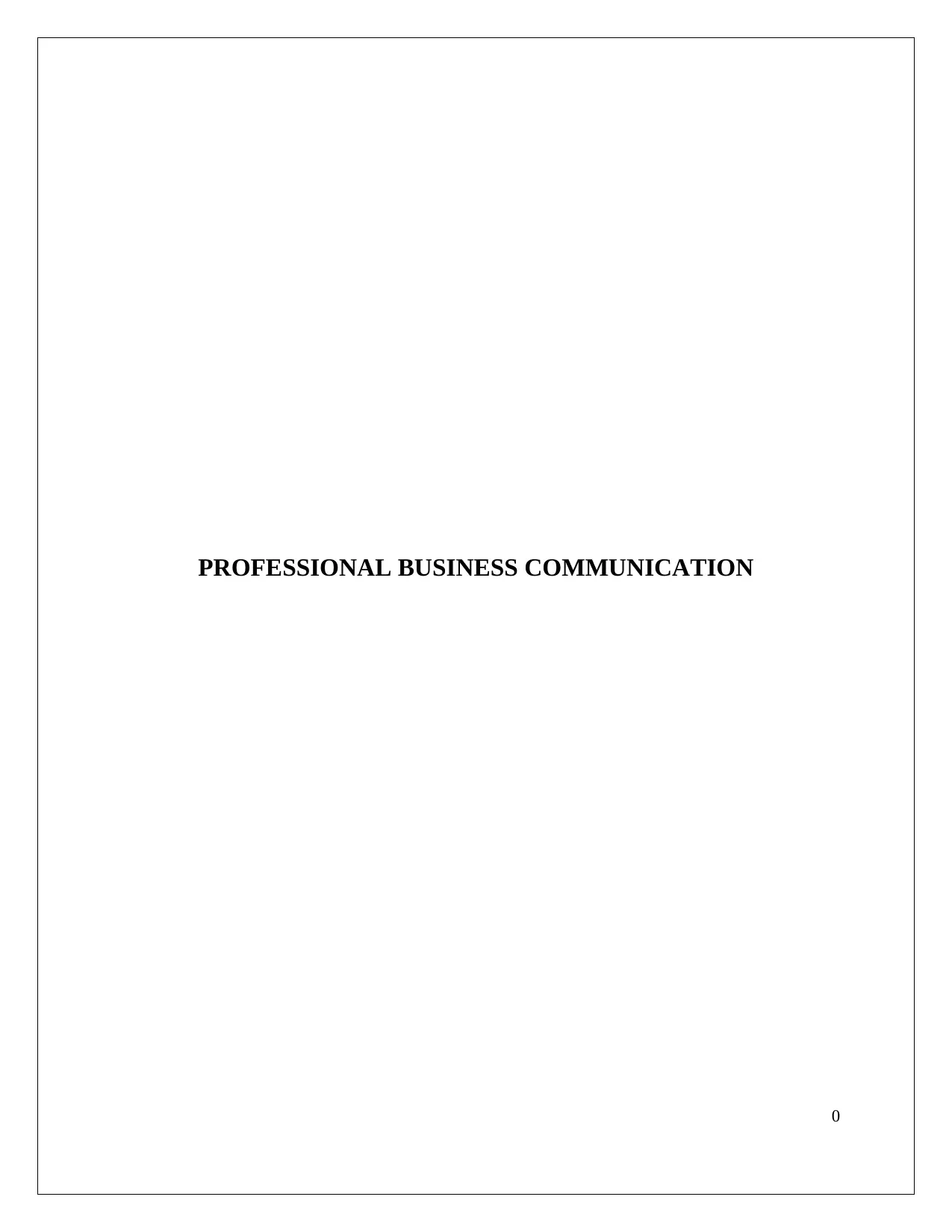
PROFESSIONAL BUSINESS COMMUNICATION
0
0
Paraphrase This Document
Need a fresh take? Get an instant paraphrase of this document with our AI Paraphraser
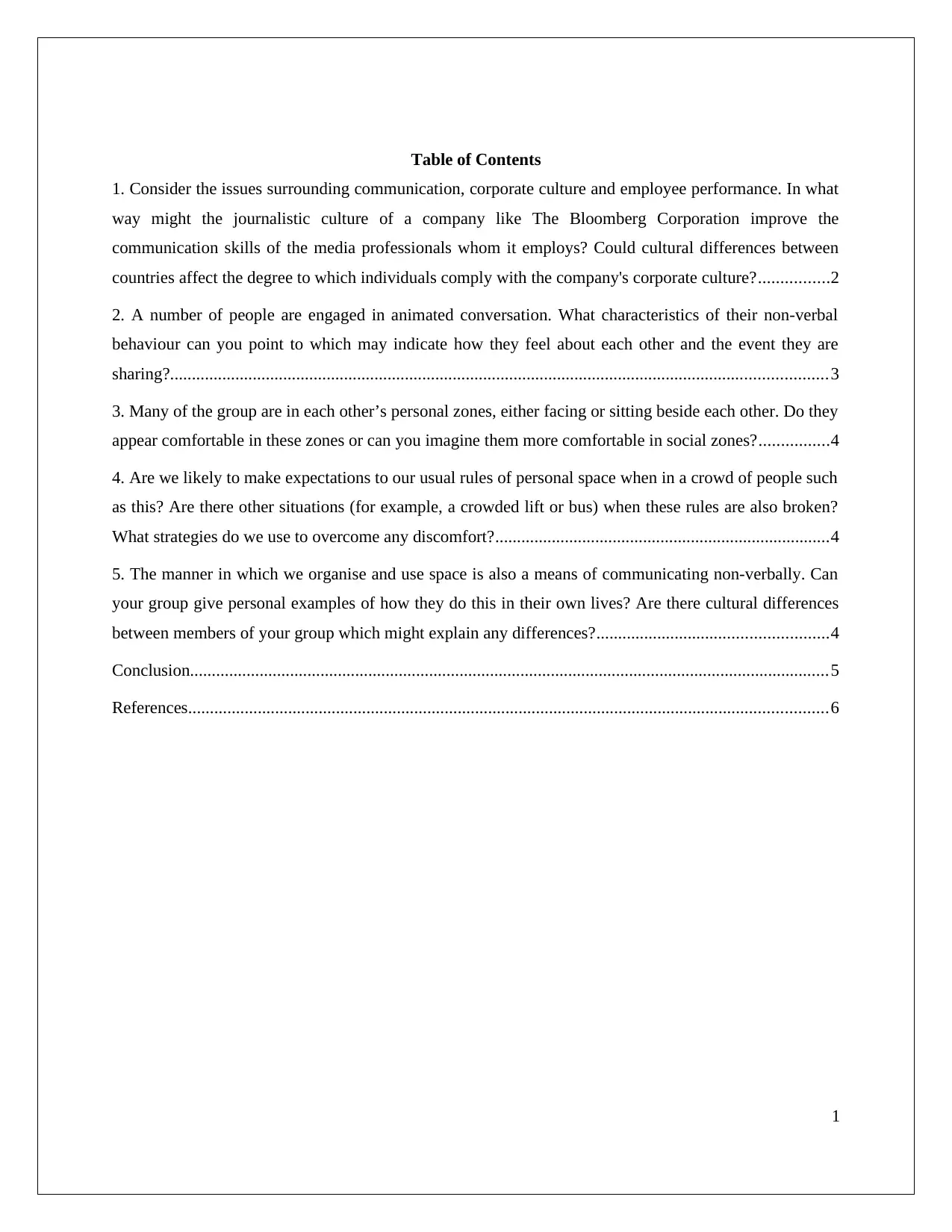
Table of Contents
1. Consider the issues surrounding communication, corporate culture and employee performance. In what
way might the journalistic culture of a company like The Bloomberg Corporation improve the
communication skills of the media professionals whom it employs? Could cultural differences between
countries affect the degree to which individuals comply with the company's corporate culture?................2
2. A number of people are engaged in animated conversation. What characteristics of their non-verbal
behaviour can you point to which may indicate how they feel about each other and the event they are
sharing?.......................................................................................................................................................3
3. Many of the group are in each other’s personal zones, either facing or sitting beside each other. Do they
appear comfortable in these zones or can you imagine them more comfortable in social zones?................4
4. Are we likely to make expectations to our usual rules of personal space when in a crowd of people such
as this? Are there other situations (for example, a crowded lift or bus) when these rules are also broken?
What strategies do we use to overcome any discomfort?.............................................................................4
5. The manner in which we organise and use space is also a means of communicating non-verbally. Can
your group give personal examples of how they do this in their own lives? Are there cultural differences
between members of your group which might explain any differences?.....................................................4
Conclusion...................................................................................................................................................5
References...................................................................................................................................................6
1
1. Consider the issues surrounding communication, corporate culture and employee performance. In what
way might the journalistic culture of a company like The Bloomberg Corporation improve the
communication skills of the media professionals whom it employs? Could cultural differences between
countries affect the degree to which individuals comply with the company's corporate culture?................2
2. A number of people are engaged in animated conversation. What characteristics of their non-verbal
behaviour can you point to which may indicate how they feel about each other and the event they are
sharing?.......................................................................................................................................................3
3. Many of the group are in each other’s personal zones, either facing or sitting beside each other. Do they
appear comfortable in these zones or can you imagine them more comfortable in social zones?................4
4. Are we likely to make expectations to our usual rules of personal space when in a crowd of people such
as this? Are there other situations (for example, a crowded lift or bus) when these rules are also broken?
What strategies do we use to overcome any discomfort?.............................................................................4
5. The manner in which we organise and use space is also a means of communicating non-verbally. Can
your group give personal examples of how they do this in their own lives? Are there cultural differences
between members of your group which might explain any differences?.....................................................4
Conclusion...................................................................................................................................................5
References...................................................................................................................................................6
1
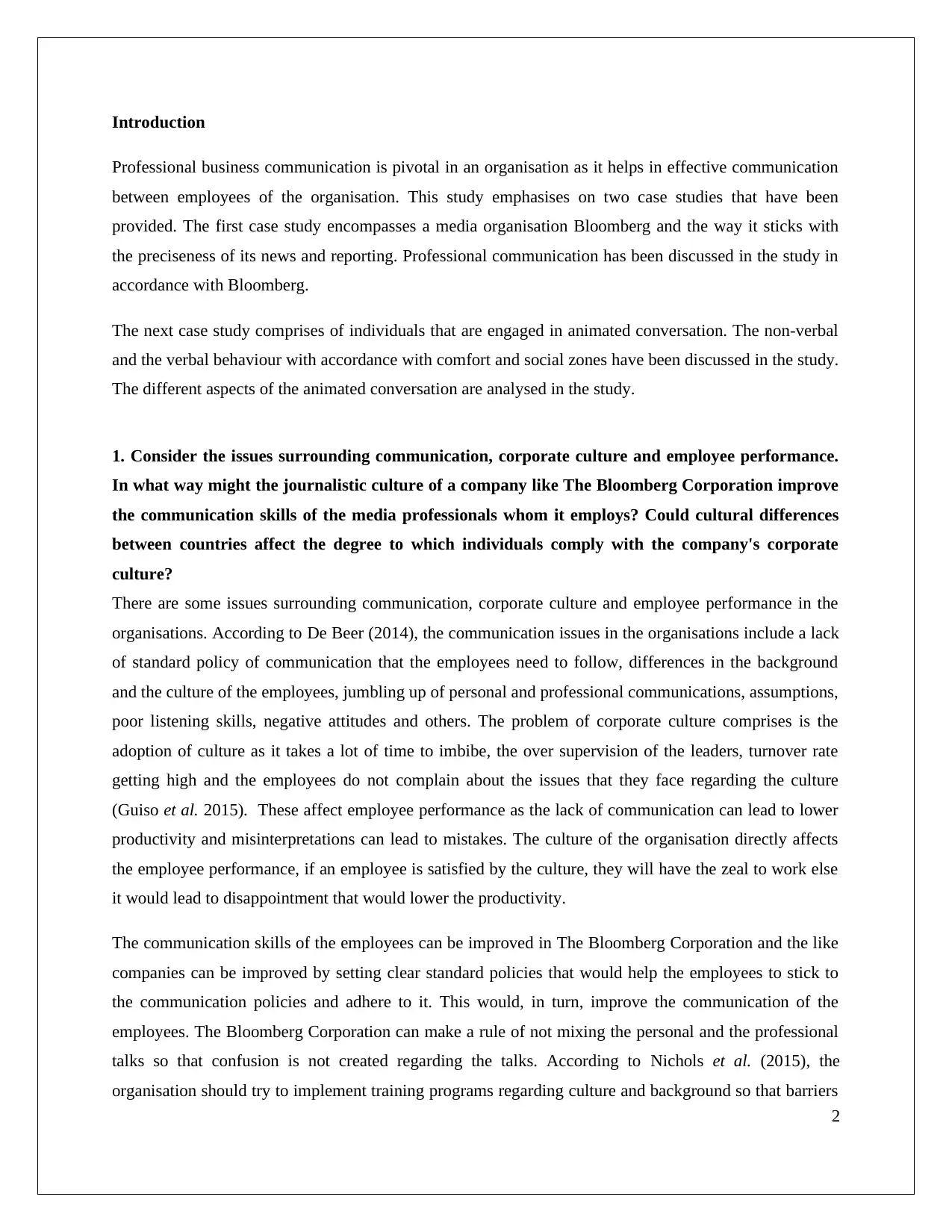
Introduction
Professional business communication is pivotal in an organisation as it helps in effective communication
between employees of the organisation. This study emphasises on two case studies that have been
provided. The first case study encompasses a media organisation Bloomberg and the way it sticks with
the preciseness of its news and reporting. Professional communication has been discussed in the study in
accordance with Bloomberg.
The next case study comprises of individuals that are engaged in animated conversation. The non-verbal
and the verbal behaviour with accordance with comfort and social zones have been discussed in the study.
The different aspects of the animated conversation are analysed in the study.
1. Consider the issues surrounding communication, corporate culture and employee performance.
In what way might the journalistic culture of a company like The Bloomberg Corporation improve
the communication skills of the media professionals whom it employs? Could cultural differences
between countries affect the degree to which individuals comply with the company's corporate
culture?
There are some issues surrounding communication, corporate culture and employee performance in the
organisations. According to De Beer (2014), the communication issues in the organisations include a lack
of standard policy of communication that the employees need to follow, differences in the background
and the culture of the employees, jumbling up of personal and professional communications, assumptions,
poor listening skills, negative attitudes and others. The problem of corporate culture comprises is the
adoption of culture as it takes a lot of time to imbibe, the over supervision of the leaders, turnover rate
getting high and the employees do not complain about the issues that they face regarding the culture
(Guiso et al. 2015). These affect employee performance as the lack of communication can lead to lower
productivity and misinterpretations can lead to mistakes. The culture of the organisation directly affects
the employee performance, if an employee is satisfied by the culture, they will have the zeal to work else
it would lead to disappointment that would lower the productivity.
The communication skills of the employees can be improved in The Bloomberg Corporation and the like
companies can be improved by setting clear standard policies that would help the employees to stick to
the communication policies and adhere to it. This would, in turn, improve the communication of the
employees. The Bloomberg Corporation can make a rule of not mixing the personal and the professional
talks so that confusion is not created regarding the talks. According to Nichols et al. (2015), the
organisation should try to implement training programs regarding culture and background so that barriers
2
Professional business communication is pivotal in an organisation as it helps in effective communication
between employees of the organisation. This study emphasises on two case studies that have been
provided. The first case study encompasses a media organisation Bloomberg and the way it sticks with
the preciseness of its news and reporting. Professional communication has been discussed in the study in
accordance with Bloomberg.
The next case study comprises of individuals that are engaged in animated conversation. The non-verbal
and the verbal behaviour with accordance with comfort and social zones have been discussed in the study.
The different aspects of the animated conversation are analysed in the study.
1. Consider the issues surrounding communication, corporate culture and employee performance.
In what way might the journalistic culture of a company like The Bloomberg Corporation improve
the communication skills of the media professionals whom it employs? Could cultural differences
between countries affect the degree to which individuals comply with the company's corporate
culture?
There are some issues surrounding communication, corporate culture and employee performance in the
organisations. According to De Beer (2014), the communication issues in the organisations include a lack
of standard policy of communication that the employees need to follow, differences in the background
and the culture of the employees, jumbling up of personal and professional communications, assumptions,
poor listening skills, negative attitudes and others. The problem of corporate culture comprises is the
adoption of culture as it takes a lot of time to imbibe, the over supervision of the leaders, turnover rate
getting high and the employees do not complain about the issues that they face regarding the culture
(Guiso et al. 2015). These affect employee performance as the lack of communication can lead to lower
productivity and misinterpretations can lead to mistakes. The culture of the organisation directly affects
the employee performance, if an employee is satisfied by the culture, they will have the zeal to work else
it would lead to disappointment that would lower the productivity.
The communication skills of the employees can be improved in The Bloomberg Corporation and the like
companies can be improved by setting clear standard policies that would help the employees to stick to
the communication policies and adhere to it. This would, in turn, improve the communication of the
employees. The Bloomberg Corporation can make a rule of not mixing the personal and the professional
talks so that confusion is not created regarding the talks. According to Nichols et al. (2015), the
organisation should try to implement training programs regarding culture and background so that barriers
2
⊘ This is a preview!⊘
Do you want full access?
Subscribe today to unlock all pages.

Trusted by 1+ million students worldwide
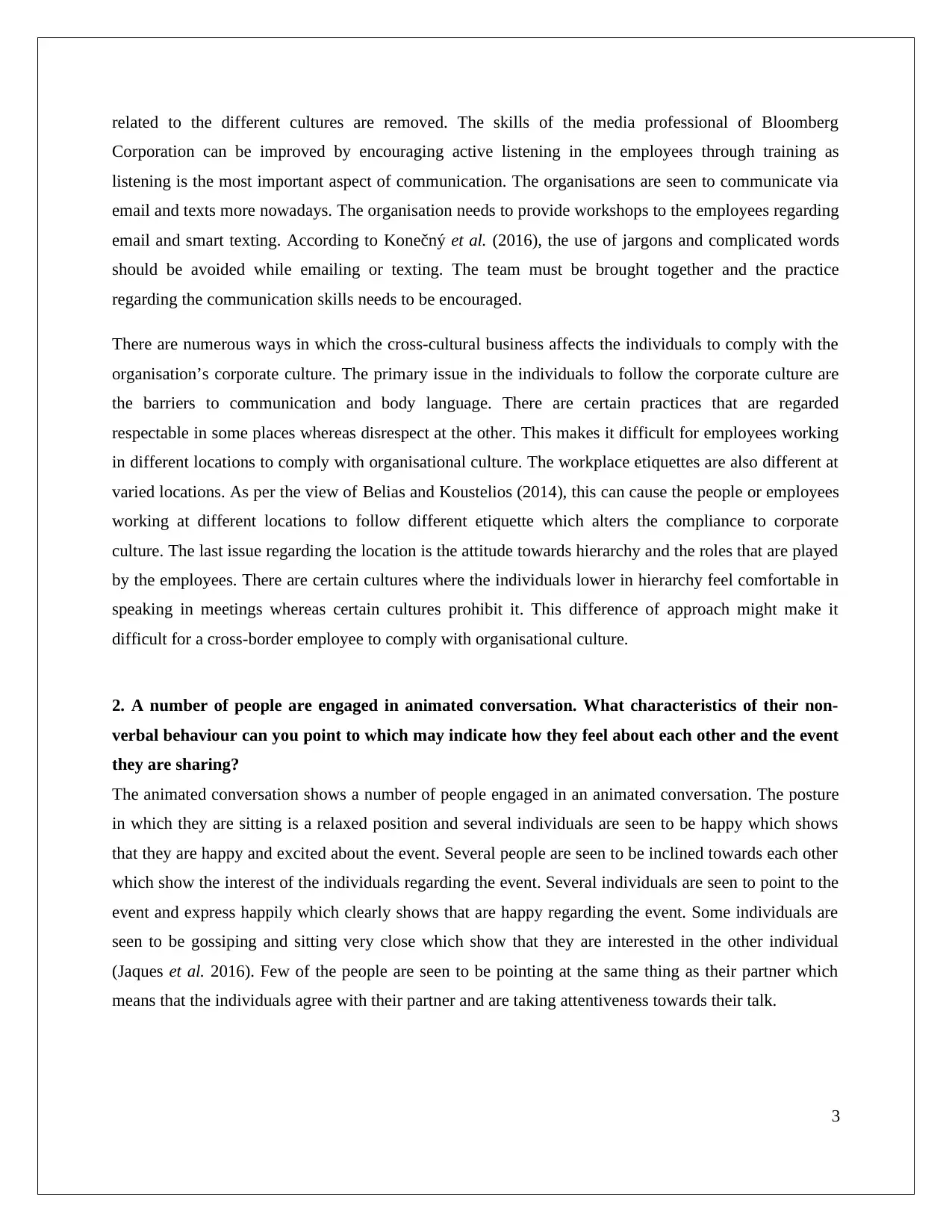
related to the different cultures are removed. The skills of the media professional of Bloomberg
Corporation can be improved by encouraging active listening in the employees through training as
listening is the most important aspect of communication. The organisations are seen to communicate via
email and texts more nowadays. The organisation needs to provide workshops to the employees regarding
email and smart texting. According to Konečný et al. (2016), the use of jargons and complicated words
should be avoided while emailing or texting. The team must be brought together and the practice
regarding the communication skills needs to be encouraged.
There are numerous ways in which the cross-cultural business affects the individuals to comply with the
organisation’s corporate culture. The primary issue in the individuals to follow the corporate culture are
the barriers to communication and body language. There are certain practices that are regarded
respectable in some places whereas disrespect at the other. This makes it difficult for employees working
in different locations to comply with organisational culture. The workplace etiquettes are also different at
varied locations. As per the view of Belias and Koustelios (2014), this can cause the people or employees
working at different locations to follow different etiquette which alters the compliance to corporate
culture. The last issue regarding the location is the attitude towards hierarchy and the roles that are played
by the employees. There are certain cultures where the individuals lower in hierarchy feel comfortable in
speaking in meetings whereas certain cultures prohibit it. This difference of approach might make it
difficult for a cross-border employee to comply with organisational culture.
2. A number of people are engaged in animated conversation. What characteristics of their non-
verbal behaviour can you point to which may indicate how they feel about each other and the event
they are sharing?
The animated conversation shows a number of people engaged in an animated conversation. The posture
in which they are sitting is a relaxed position and several individuals are seen to be happy which shows
that they are happy and excited about the event. Several people are seen to be inclined towards each other
which show the interest of the individuals regarding the event. Several individuals are seen to point to the
event and express happily which clearly shows that are happy regarding the event. Some individuals are
seen to be gossiping and sitting very close which show that they are interested in the other individual
(Jaques et al. 2016). Few of the people are seen to be pointing at the same thing as their partner which
means that the individuals agree with their partner and are taking attentiveness towards their talk.
3
Corporation can be improved by encouraging active listening in the employees through training as
listening is the most important aspect of communication. The organisations are seen to communicate via
email and texts more nowadays. The organisation needs to provide workshops to the employees regarding
email and smart texting. According to Konečný et al. (2016), the use of jargons and complicated words
should be avoided while emailing or texting. The team must be brought together and the practice
regarding the communication skills needs to be encouraged.
There are numerous ways in which the cross-cultural business affects the individuals to comply with the
organisation’s corporate culture. The primary issue in the individuals to follow the corporate culture are
the barriers to communication and body language. There are certain practices that are regarded
respectable in some places whereas disrespect at the other. This makes it difficult for employees working
in different locations to comply with organisational culture. The workplace etiquettes are also different at
varied locations. As per the view of Belias and Koustelios (2014), this can cause the people or employees
working at different locations to follow different etiquette which alters the compliance to corporate
culture. The last issue regarding the location is the attitude towards hierarchy and the roles that are played
by the employees. There are certain cultures where the individuals lower in hierarchy feel comfortable in
speaking in meetings whereas certain cultures prohibit it. This difference of approach might make it
difficult for a cross-border employee to comply with organisational culture.
2. A number of people are engaged in animated conversation. What characteristics of their non-
verbal behaviour can you point to which may indicate how they feel about each other and the event
they are sharing?
The animated conversation shows a number of people engaged in an animated conversation. The posture
in which they are sitting is a relaxed position and several individuals are seen to be happy which shows
that they are happy and excited about the event. Several people are seen to be inclined towards each other
which show the interest of the individuals regarding the event. Several individuals are seen to point to the
event and express happily which clearly shows that are happy regarding the event. Some individuals are
seen to be gossiping and sitting very close which show that they are interested in the other individual
(Jaques et al. 2016). Few of the people are seen to be pointing at the same thing as their partner which
means that the individuals agree with their partner and are taking attentiveness towards their talk.
3
Paraphrase This Document
Need a fresh take? Get an instant paraphrase of this document with our AI Paraphraser
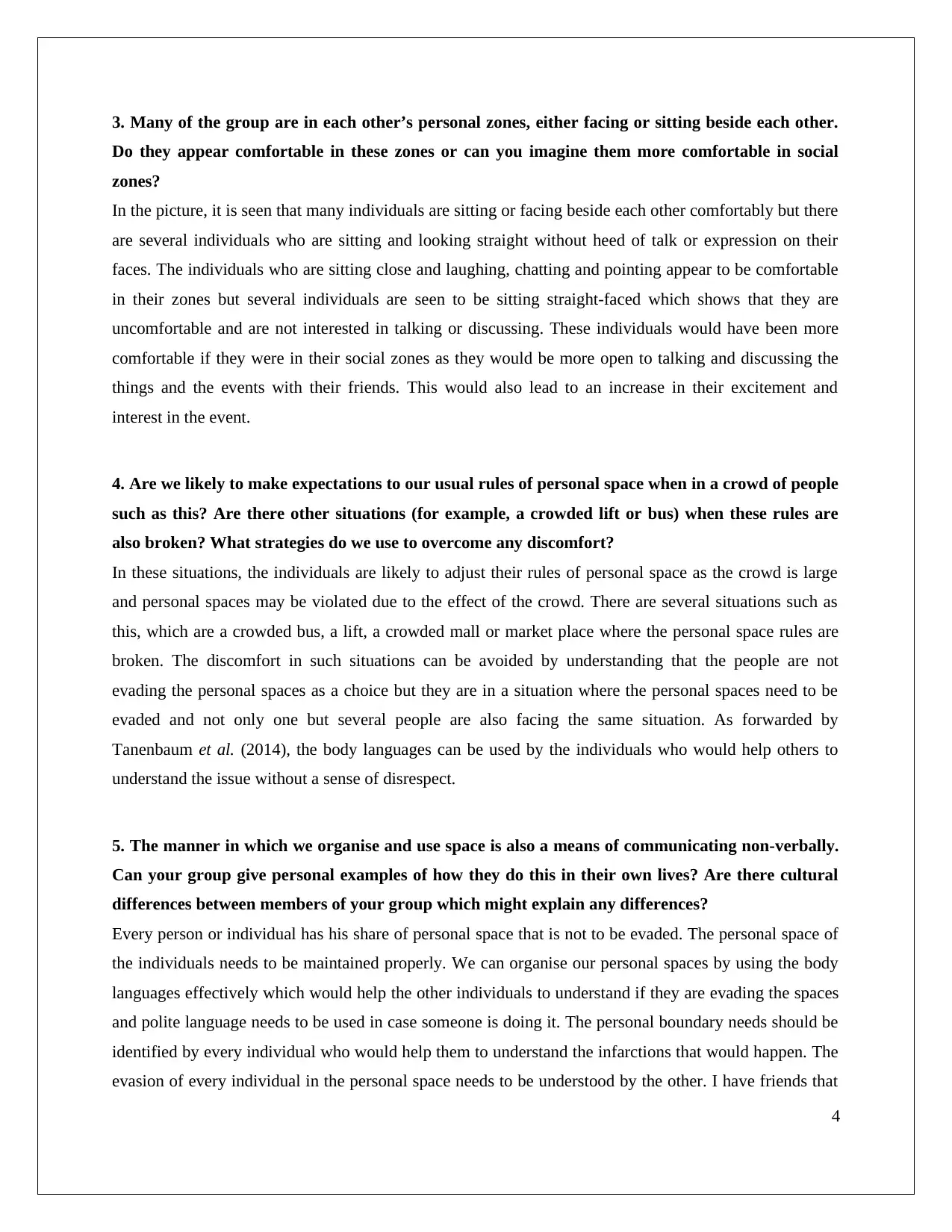
3. Many of the group are in each other’s personal zones, either facing or sitting beside each other.
Do they appear comfortable in these zones or can you imagine them more comfortable in social
zones?
In the picture, it is seen that many individuals are sitting or facing beside each other comfortably but there
are several individuals who are sitting and looking straight without heed of talk or expression on their
faces. The individuals who are sitting close and laughing, chatting and pointing appear to be comfortable
in their zones but several individuals are seen to be sitting straight-faced which shows that they are
uncomfortable and are not interested in talking or discussing. These individuals would have been more
comfortable if they were in their social zones as they would be more open to talking and discussing the
things and the events with their friends. This would also lead to an increase in their excitement and
interest in the event.
4. Are we likely to make expectations to our usual rules of personal space when in a crowd of people
such as this? Are there other situations (for example, a crowded lift or bus) when these rules are
also broken? What strategies do we use to overcome any discomfort?
In these situations, the individuals are likely to adjust their rules of personal space as the crowd is large
and personal spaces may be violated due to the effect of the crowd. There are several situations such as
this, which are a crowded bus, a lift, a crowded mall or market place where the personal space rules are
broken. The discomfort in such situations can be avoided by understanding that the people are not
evading the personal spaces as a choice but they are in a situation where the personal spaces need to be
evaded and not only one but several people are also facing the same situation. As forwarded by
Tanenbaum et al. (2014), the body languages can be used by the individuals who would help others to
understand the issue without a sense of disrespect.
5. The manner in which we organise and use space is also a means of communicating non-verbally.
Can your group give personal examples of how they do this in their own lives? Are there cultural
differences between members of your group which might explain any differences?
Every person or individual has his share of personal space that is not to be evaded. The personal space of
the individuals needs to be maintained properly. We can organise our personal spaces by using the body
languages effectively which would help the other individuals to understand if they are evading the spaces
and polite language needs to be used in case someone is doing it. The personal boundary needs should be
identified by every individual who would help them to understand the infarctions that would happen. The
evasion of every individual in the personal space needs to be understood by the other. I have friends that
4
Do they appear comfortable in these zones or can you imagine them more comfortable in social
zones?
In the picture, it is seen that many individuals are sitting or facing beside each other comfortably but there
are several individuals who are sitting and looking straight without heed of talk or expression on their
faces. The individuals who are sitting close and laughing, chatting and pointing appear to be comfortable
in their zones but several individuals are seen to be sitting straight-faced which shows that they are
uncomfortable and are not interested in talking or discussing. These individuals would have been more
comfortable if they were in their social zones as they would be more open to talking and discussing the
things and the events with their friends. This would also lead to an increase in their excitement and
interest in the event.
4. Are we likely to make expectations to our usual rules of personal space when in a crowd of people
such as this? Are there other situations (for example, a crowded lift or bus) when these rules are
also broken? What strategies do we use to overcome any discomfort?
In these situations, the individuals are likely to adjust their rules of personal space as the crowd is large
and personal spaces may be violated due to the effect of the crowd. There are several situations such as
this, which are a crowded bus, a lift, a crowded mall or market place where the personal space rules are
broken. The discomfort in such situations can be avoided by understanding that the people are not
evading the personal spaces as a choice but they are in a situation where the personal spaces need to be
evaded and not only one but several people are also facing the same situation. As forwarded by
Tanenbaum et al. (2014), the body languages can be used by the individuals who would help others to
understand the issue without a sense of disrespect.
5. The manner in which we organise and use space is also a means of communicating non-verbally.
Can your group give personal examples of how they do this in their own lives? Are there cultural
differences between members of your group which might explain any differences?
Every person or individual has his share of personal space that is not to be evaded. The personal space of
the individuals needs to be maintained properly. We can organise our personal spaces by using the body
languages effectively which would help the other individuals to understand if they are evading the spaces
and polite language needs to be used in case someone is doing it. The personal boundary needs should be
identified by every individual who would help them to understand the infarctions that would happen. The
evasion of every individual in the personal space needs to be understood by the other. I have friends that
4
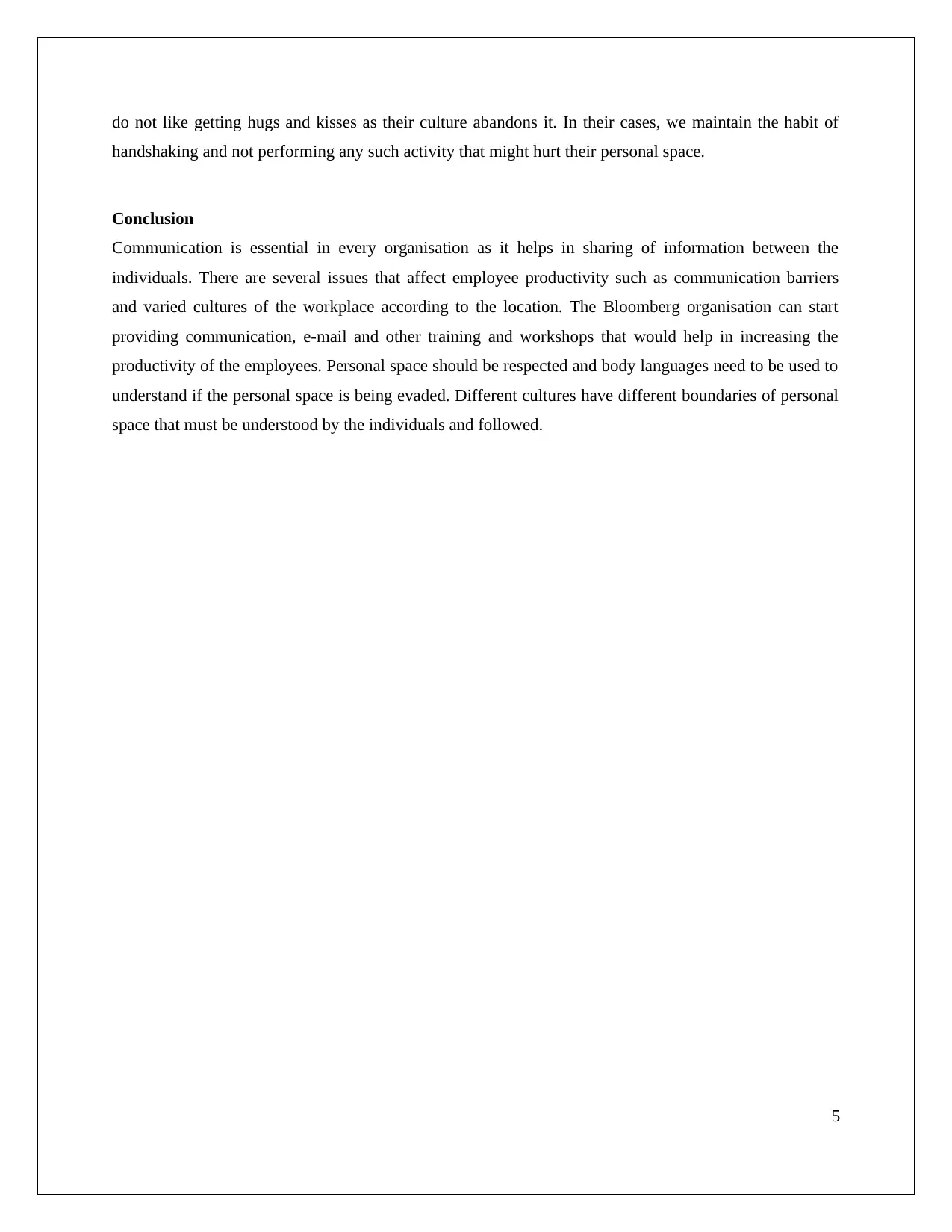
do not like getting hugs and kisses as their culture abandons it. In their cases, we maintain the habit of
handshaking and not performing any such activity that might hurt their personal space.
Conclusion
Communication is essential in every organisation as it helps in sharing of information between the
individuals. There are several issues that affect employee productivity such as communication barriers
and varied cultures of the workplace according to the location. The Bloomberg organisation can start
providing communication, e-mail and other training and workshops that would help in increasing the
productivity of the employees. Personal space should be respected and body languages need to be used to
understand if the personal space is being evaded. Different cultures have different boundaries of personal
space that must be understood by the individuals and followed.
5
handshaking and not performing any such activity that might hurt their personal space.
Conclusion
Communication is essential in every organisation as it helps in sharing of information between the
individuals. There are several issues that affect employee productivity such as communication barriers
and varied cultures of the workplace according to the location. The Bloomberg organisation can start
providing communication, e-mail and other training and workshops that would help in increasing the
productivity of the employees. Personal space should be respected and body languages need to be used to
understand if the personal space is being evaded. Different cultures have different boundaries of personal
space that must be understood by the individuals and followed.
5
⊘ This is a preview!⊘
Do you want full access?
Subscribe today to unlock all pages.

Trusted by 1+ million students worldwide
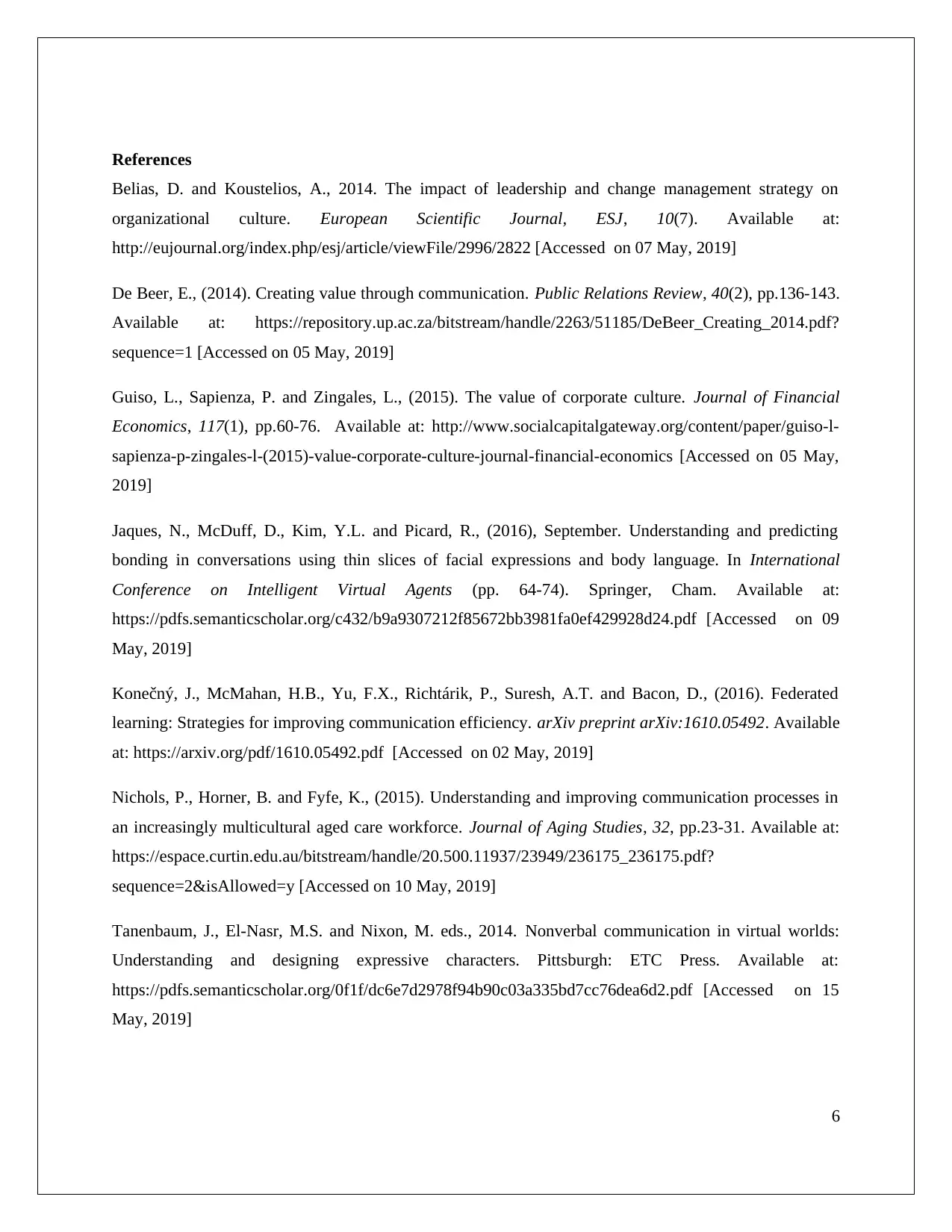
References
Belias, D. and Koustelios, A., 2014. The impact of leadership and change management strategy on
organizational culture. European Scientific Journal, ESJ, 10(7). Available at:
http://eujournal.org/index.php/esj/article/viewFile/2996/2822 [Accessed on 07 May, 2019]
De Beer, E., (2014). Creating value through communication. Public Relations Review, 40(2), pp.136-143.
Available at: https://repository.up.ac.za/bitstream/handle/2263/51185/DeBeer_Creating_2014.pdf?
sequence=1 [Accessed on 05 May, 2019]
Guiso, L., Sapienza, P. and Zingales, L., (2015). The value of corporate culture. Journal of Financial
Economics, 117(1), pp.60-76. Available at: http://www.socialcapitalgateway.org/content/paper/guiso-l-
sapienza-p-zingales-l-(2015)-value-corporate-culture-journal-financial-economics [Accessed on 05 May,
2019]
Jaques, N., McDuff, D., Kim, Y.L. and Picard, R., (2016), September. Understanding and predicting
bonding in conversations using thin slices of facial expressions and body language. In International
Conference on Intelligent Virtual Agents (pp. 64-74). Springer, Cham. Available at:
https://pdfs.semanticscholar.org/c432/b9a9307212f85672bb3981fa0ef429928d24.pdf [Accessed on 09
May, 2019]
Konečný, J., McMahan, H.B., Yu, F.X., Richtárik, P., Suresh, A.T. and Bacon, D., (2016). Federated
learning: Strategies for improving communication efficiency. arXiv preprint arXiv:1610.05492. Available
at: https://arxiv.org/pdf/1610.05492.pdf [Accessed on 02 May, 2019]
Nichols, P., Horner, B. and Fyfe, K., (2015). Understanding and improving communication processes in
an increasingly multicultural aged care workforce. Journal of Aging Studies, 32, pp.23-31. Available at:
https://espace.curtin.edu.au/bitstream/handle/20.500.11937/23949/236175_236175.pdf?
sequence=2&isAllowed=y [Accessed on 10 May, 2019]
Tanenbaum, J., El-Nasr, M.S. and Nixon, M. eds., 2014. Nonverbal communication in virtual worlds:
Understanding and designing expressive characters. Pittsburgh: ETC Press. Available at:
https://pdfs.semanticscholar.org/0f1f/dc6e7d2978f94b90c03a335bd7cc76dea6d2.pdf [Accessed on 15
May, 2019]
6
Belias, D. and Koustelios, A., 2014. The impact of leadership and change management strategy on
organizational culture. European Scientific Journal, ESJ, 10(7). Available at:
http://eujournal.org/index.php/esj/article/viewFile/2996/2822 [Accessed on 07 May, 2019]
De Beer, E., (2014). Creating value through communication. Public Relations Review, 40(2), pp.136-143.
Available at: https://repository.up.ac.za/bitstream/handle/2263/51185/DeBeer_Creating_2014.pdf?
sequence=1 [Accessed on 05 May, 2019]
Guiso, L., Sapienza, P. and Zingales, L., (2015). The value of corporate culture. Journal of Financial
Economics, 117(1), pp.60-76. Available at: http://www.socialcapitalgateway.org/content/paper/guiso-l-
sapienza-p-zingales-l-(2015)-value-corporate-culture-journal-financial-economics [Accessed on 05 May,
2019]
Jaques, N., McDuff, D., Kim, Y.L. and Picard, R., (2016), September. Understanding and predicting
bonding in conversations using thin slices of facial expressions and body language. In International
Conference on Intelligent Virtual Agents (pp. 64-74). Springer, Cham. Available at:
https://pdfs.semanticscholar.org/c432/b9a9307212f85672bb3981fa0ef429928d24.pdf [Accessed on 09
May, 2019]
Konečný, J., McMahan, H.B., Yu, F.X., Richtárik, P., Suresh, A.T. and Bacon, D., (2016). Federated
learning: Strategies for improving communication efficiency. arXiv preprint arXiv:1610.05492. Available
at: https://arxiv.org/pdf/1610.05492.pdf [Accessed on 02 May, 2019]
Nichols, P., Horner, B. and Fyfe, K., (2015). Understanding and improving communication processes in
an increasingly multicultural aged care workforce. Journal of Aging Studies, 32, pp.23-31. Available at:
https://espace.curtin.edu.au/bitstream/handle/20.500.11937/23949/236175_236175.pdf?
sequence=2&isAllowed=y [Accessed on 10 May, 2019]
Tanenbaum, J., El-Nasr, M.S. and Nixon, M. eds., 2014. Nonverbal communication in virtual worlds:
Understanding and designing expressive characters. Pittsburgh: ETC Press. Available at:
https://pdfs.semanticscholar.org/0f1f/dc6e7d2978f94b90c03a335bd7cc76dea6d2.pdf [Accessed on 15
May, 2019]
6
1 out of 7
Related Documents
Your All-in-One AI-Powered Toolkit for Academic Success.
+13062052269
info@desklib.com
Available 24*7 on WhatsApp / Email
![[object Object]](/_next/static/media/star-bottom.7253800d.svg)
Unlock your academic potential
Copyright © 2020–2025 A2Z Services. All Rights Reserved. Developed and managed by ZUCOL.





